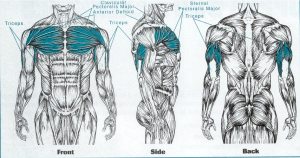What is the barbell bench press?
The barbell bench press is the original upper body mass builder. It has been used by bodybuilders since the sport began. It is also the yardstick with which strength trainers measure their upper body pressing strength.
Whilst it is possibly the most popular resistance exercise in most gyms, it is often performed incorrectly with poor form. Deadlifts aside, there is probably no other exercise that is responsible for more injuries in the gym than the barbell bench press.
In this article, we will analyse the movement, common mistakes and how to get the most from your bench press.
Which muscles are worked by the barbell bench press?
The target muscles for a barbell bench press are the pectoral muscles in the chest. A flat bench will work the upper and midsection of the pectoral, an incline bench will put emphasis on the top portion and a decline press will activate the lower and midsection.
In this article, we will focus on a flat bench press.
A flat bench press will activate the anterior deltoids (front of the shoulder) and tricep muscles (back of the upper arm) as it is an upper-body pressing exercise.
These muscles are known as the secondary target muscles as they assist the pectorals in pressing the weight and their fibres will be broken down by the movement. To a lesser extent, the forearm muscles are engaged as stabilisers to keep the wrists rigid.
For bodybuilders, all chest routines should incorporate some kind of pressing movement. This could be a bench press, machine chest press or dumbbell press. Pressing exercises are the ultimate exercise for adding mass to the front of the upper body.
How do I do a barbell bench press?
The majority of gyms will have at least one dedicated flat bench for pressing. If yours does not, you can wheel a dumbbell bench into a rack, attach hooks to the rack, add a loaded bar and press away.

- Load the bar (one side at a time) with the desired weight. Start light and pyramid upwards.
- Lie on the bench. Get your feet into a wide stance for stability. Arch your back so that your lower back is lifted off of the bench and your upper back is ready to take the strain.
- Grip the bar just wider than shoulder-width and lower it to your chest. This is your starting position.
- Take a deep breath, upon exhale, press the weight in an upwards motion. Flare the elbows slightly for maximum stability of the bar.
- Before you fully straighten the arms, stop the movement short and squeeze the pecs for a couple of seconds before bringing the bar back down in a slow, controlled motion.
- Before the bar touches your chest, start the pressing movement again and repeat for the required number of reps and sets.
Tips for the barbell bench press.
- Make sure that your lower back is arched off of the bench and your upper back is taking the strain.
- Press upwards with an explosive movement and lower the weight with a controlled motion. This activates both the fast twitch and slow twitch fibres in the pectoral muscles.
- By not locking out at the top or resting the bar at the bottom of the movement, you are keeping the muscles under constant strain and maximising time under tension.
- If you can, get somebody to spot you. Having a spotter will help you push to failure without worrying about getting crushed under the weight. If you can not get a spotter, consider using a smith machine or a rack with safety bars.
- Wearing wrist and elbow straps is a good idea if you are going to lift heavy. They give you extra support in the joints and the confidence to push yourself to lift heavier.
- Before you lift the bar from the rack, squeeze the bar for a few seconds as tight as possible. This sends a message to the rotator cuff in the shoulder that it needs to brace itself for tension. Doing this reduces the risk of rotator cuff injury and stops any wobbles if you are lifting heavy.


